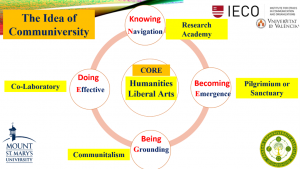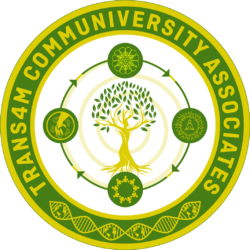
- Home
- The Idea of Communiversity & the Story Telling as Experiential Learning
- admin
- 0 Comments
- September 14, 2022

The Idea of Communiversity & the Story Telling as Experiential Learning
Prof Alejandro Cañadas
Ronnie Lessem, Anselm Adodo developed the idea of Communiversity, and Tony Bradley in their 2019 book “The idea of Communiversity: Releasing the Natural, Cultural, Technological and Economic GENE-ius of Societies.” Their book has practically responded to the educational crisis they have surveyed worldwide, where schooling remains inaccessible for many communities. Their book became a prophetic message addressing these critical issues because it was published right before the Covid pandemic, which deepened the access to education for millions of people. Their research is not only an assessment of our global educational problems but also a proposal to help reflect how current educational institutions like Mount St. Mary’s University play a more active role in the transformation of our academic programs.
The idea of Communiversity as a transformational practical model for the Mount will help us increase our students’ learning experiences by integrating them into our local communities where the Mount can have an integral impact.
In their book, Lessem, Adodo, and Bradley used the integral world’s approach to transform how universities participate in knowledge creation. This reflection about transforming our university educational program is based on Cardenal John Henry Newman’s original 1852 lectures, which later became collected with the other works as The Idea of a University,[1] which has become a masterpiece of literature for its reflection of the nature of education.
Building on Newman’s foundation, Lessem, Adodo, and Bradley, created a practical map or dynamic journey to implement an integral transformational applicable model for experiential learning in our universities. This experimental model has been implemented in Africa, Asia, and Europe.
Lessem, Adodo, and Bradley built the idea of Communiversity using the four principles proposed by Newman’s original work. They adapted for a practical implementation using the four-world model theory for transformational development.
The four principles upon which the idea Newman’s idea of Communiversity is founded are:
- The solidaristic principle of communitalism (as opposed to simplistic dichotomies such as black and white, capitalism or communism, right or left) is necessary to ground our knowledge creation in a community. This is aligned to the being in the four-world model south.
- The spiritual principle of pilgrimium (as opposed to doctrinally static and isolated ideas or faiths), which is necessary for Emerging human well-being (human dignity, good work, and human flourishing), cannot be disconnected from our knowledge creation process. This is aligned to the Becoming in the four-world model east.
- The Scientia/sapiential principle of the academy (as opposed to fragmented or isolated disciplinary departments) is necessary for Navigating toward the emancipation of cultural knowledge. This is aligned to the Knowing in the four-world model north.
- The societal principle of working in (a) co-laboratory (way) (as opposed to solo, ‘heroic,’ individualistic, and profit-maximizing entrepreneurship) is necessary for Effecting new learning-based, research-to-innovation enterprises. This is aligned to the Doing in the four-world model west.
The principle of communitalism is much more than transforming the Mount into a “community-based university” (or comm-university), which we are already a “community-based university” in Emmitsburg, Md, and in Frederick, Md. The principle of communitalism implies transforming the Mount into a communi-versity, where the prefix communi connects the ideas of community to communion. At the same time, the suffix derives from the Latin vertere, meaning to turn or to transform. We are talking about a transformation or a turning that takes place in the community to communion.
It is interesting to note that the suffix Vertere could mean turning again, for example, in the term versus, like humanities versus (vs) sciences. However, it can equally mean contrary or alternative, rather than simply adversarial opposition. For example, we might say that ‘we studied well-being in economics versus studying only profit maximization. Indeed, the fuller meaning of Vertere for our application relates to change as transformation. For example, we might think of a caterpillar as it Vertere into a butterfly as a result of the change that takes place in the chrysalis. This is the hidden transformation of conversion that experiential learning can produce in our students and professors.
Another derivative from Vertere directly connected to the idea of the university is that of the suffix varsity. This is also a true characteristic of our universities, where varsity became associated with sporting contests between medieval English universities like Oxford and Cambridge. This is the case nowadays, where we compete in sports and academia in our universities. In both, we can use the term Vertere as turning against an oppositional contest (in sports or academia). However, we can also associate that prefix with ‘versity’ as a place of turning into, changing, and transforming, not only as individuals but also as a community. In our core curriculum at the Mount, we give a lot of emphasis to the prefix with ‘versity’ that becomes ‘virtue’ or ‘virtuous,’ which is necessary to build character or discipline to produce good work capable of respecting our human dignity and is essential for our pursuit of happiness and communal human flourishing.
In summary, we can say that the idea of communi-versity is to create at the Mount a place of transformative change for a group or community (students, faculty, staff, community members), where contrast, differences, and diversity are worked out in communion.
We believe that building experiential learning experiences using the idea of communi-versity will contribute to our ongoing conversations around Integral Ecology inspired by Pope Francis’ encyclical Letter: Laudato Si. As a project, in our classes, students will be tasked with re-telling the story of those transformative changes where contrast or differences are worked out in communities to create communion. These will become our research laboratories. We want to write these cases and produce video or audio alternatives to contribute to the digital media library to share them.
The principle of pilgrimium is the place where the change is taking place. Cardinal John Henry Newman incorporated the dimension of journeying together using the human experience of peregrination that graphically shows the dynamic journey and effort that it involves not as an individual movement but in a group, with others in communion. The principle of pilgrimium is also associated with a sanctuary to represent the sacred place where the educational transformation is taking place.
So, pilgrimium applied to the Mount will represent the place in which we, as community-in-communion, journey towards our transformative experience of the academy.
This is the principle of the academy which is the process of navigating to create innovative sources of knowledge creation at the Mount. Finally, this is a dynamic process. The knowledge developed in the academy must be implemented in the real world within our co-laboratory spaces to effect sustainable impact and synergies between the Mount and the communities our students will move to after graduation.
The Research Academy

At the Mount, we propose using the idea of communi-versity developed by Lessem, Adodo, and Bradley, as the theoretical framework for implementing the new classes and academic programs and co-creating together with other institutions like Sophia University in Loppiano, Italy.
This graph is the illustration of our proposal. We start in the south. This is us, the Mount (our being). This is the place where we want to ground and implement this proposal. We will work with interdisciplinary faculty in the Humanities with those outside the humanities to embark on a process of transforming our educational experience in the community.
In the east, we will create our experiential learning with organizations and institutions outside the Mount. This is our becoming. Here is where we will engage our students with real and living organizations in the transformational journey. By interacting with these live cases: organizations, and their communities, the students experience the process of emergence of the actual transformation taking place.
In the north, our students synthesize their learning process in those real and living organizations in the transformational journey. In each course offered at Mount, the students will produce an interactive web-based library of written case studies, video, and audio production, telling the stories of those living communities and their transformative journey.
In the west, our implementation of the grant proposal will take place by organizing the whole project using our effective collaboration within the interdisciplinary faculty at the Mount with those scholars and practitioners outside the Mount.
[1] Newman wrote Nine Discourses in the University, which later developed the Dublin lectures of 1852 There is 1996 Yale University version of The Idea of a University edited by Frank M Turner.


Leave a Comment